The greatest changes in the city's common landscape are not caused by real estate agents, the destruction of historic buildings or the construction of beautiful or disastrous skyscrapers. Major changes are instead caused by nature, demonstrating the fragility of our icons. Sandy, and now Jonas, come to reveal how vulnerable our imaginary is.
In the case of the winter storm Jonas, the first one to affect the East Coast metropolis this season, people are not having a very good time. The cold is tough but it also brings about a calm vision once the storm is over.
When we got Montse Zamorano's images from the day after the storm, we asked her about her first impressions, but above all about the typical silence that lays over everything after the storm.
In a city like New York discovering that you can listen to the silence is always a surprise:
It's strange not to hear noise in New York. However, on Saturday Jonas silenced the bustle of the city, the shouting in the streets, the sound of cars and sirens, only the blizzard was heard instead.
Excited about the first snowfall this season, we decided to go to Central Park. Once on the street, snow came from all directions. Gusts of wind blew up the snow and made it complicated to see and walk. I had my camera with me but didn't take it out in case it would get damaged, so I took all the photos with my phone.
The town was half empty and we only met a shopkeeper removing the snow in front of his store, a couple of taxis or a delivery man moving around very slowly and, surprisingly, several runners training in shorts. Meanwhile, snow was piling up on the sidewalks and in the streets. At 2:30 p.m. all travel was banned except for emergency vehicles and soon after all the shops were closed.
The day after was completely different. It was sunny and groups of friends and entire families carrying sleds and mats could be seen in the streets on their way to Central Park. People threw themselves down the slopes of the park, made snowmen or even went cross-country skiing and snowshoeing. The cars run along the main streets and some sidewalks had been cleared, but side streets were still full of snow, which had turned from white to gray.
Jonas is over now and has left a city full of snow and ice that will take weeks to disappear from the sidewalks. Meanwhile, the continuous bustle of people, beeping of cars and the sound of sirens are back.
Montse Zamorano
Montse's photographs let us discover a different, unpolluted and clean Manhattan, covered by a white mantle it becomes a pristine metaphor of itself. The images of a utopian purity for Manhattan are nothing but another delirious vision of Manhattan, transcribed by Montse Zamorano's exceptional pictures.
José Juan Barba
































